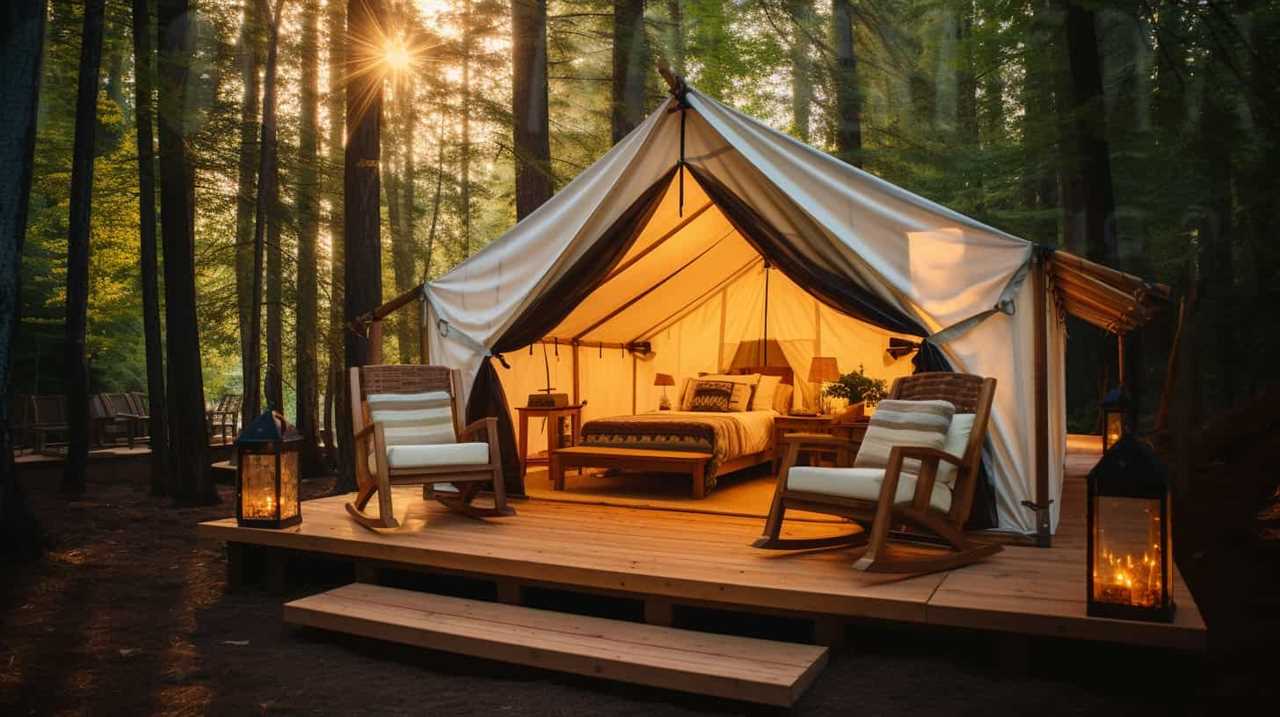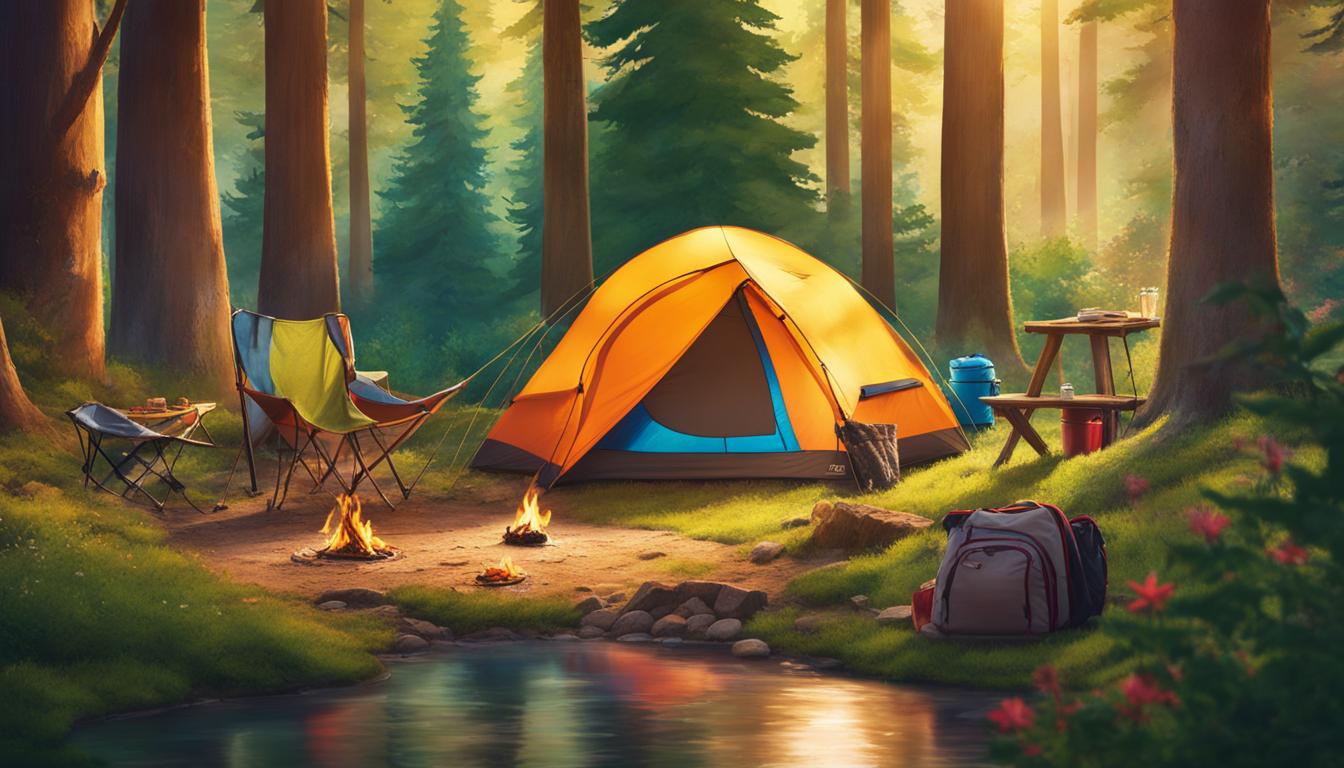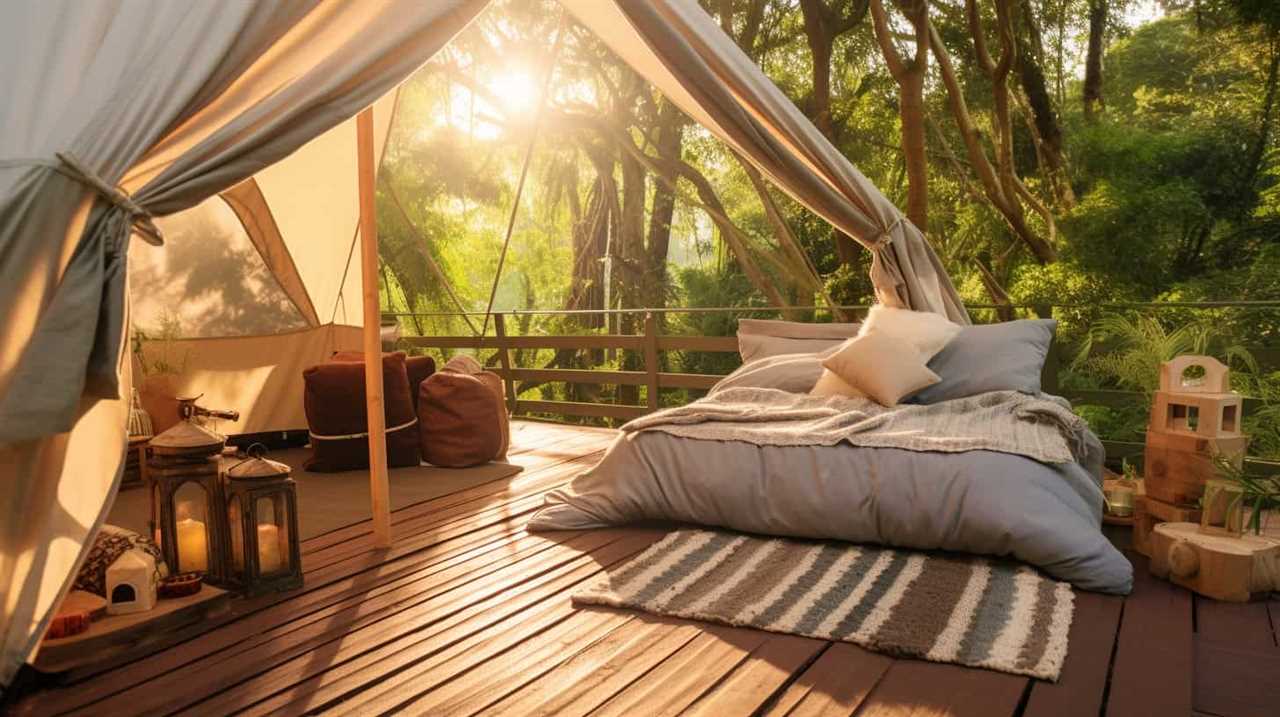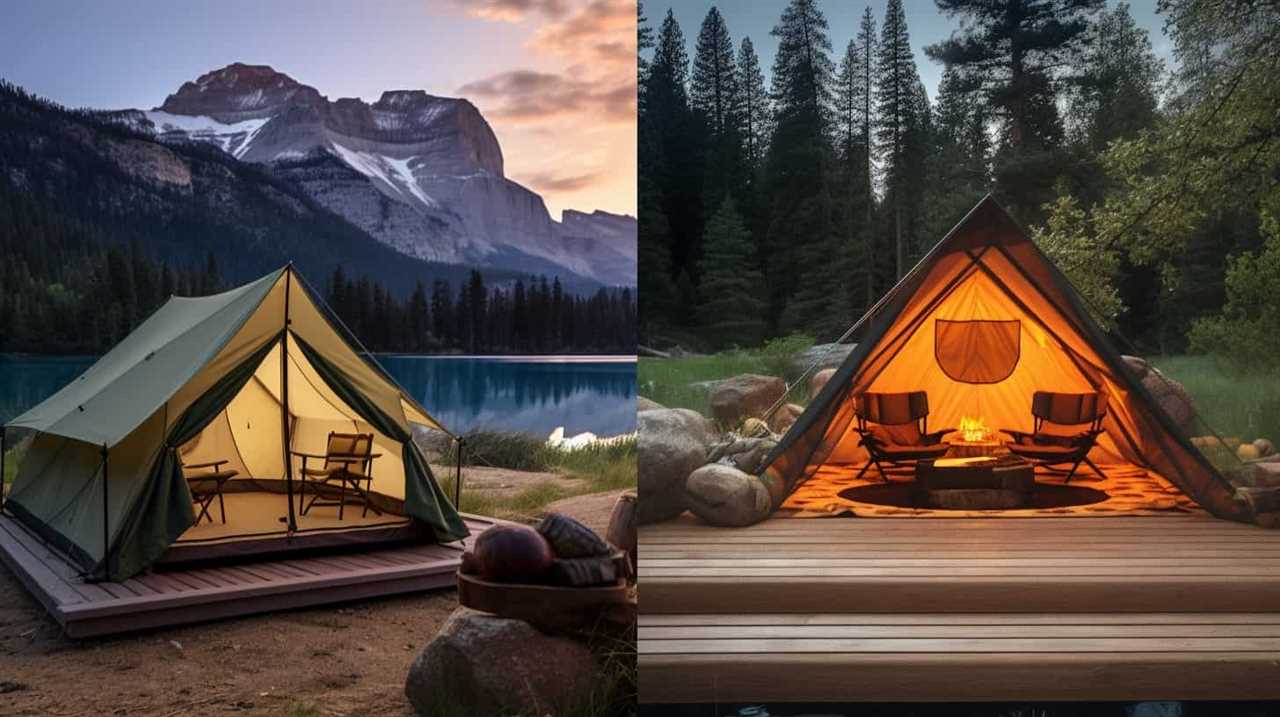Hello, fellow nature lovers!
Looking to indulge in a luxurious camping experience while still keeping it eco-friendly? Well, look no further!
In this article, we’ve got you covered with some awesome sustainable tips for your next adventure.
From choosing eco-friendly campsites to reducing your carbon footprint, we’ll show you how to enjoy the great outdoors without harming the environment.

So, let’s dive in and discover how we can make our luxury camping trips both extravagant and eco-conscious.
Key Takeaways
- Prioritize luxury campsites that align with sustainable values, such as those with recycling programs and energy-efficient facilities.
- Choose eco-friendly packaging options and minimize the use of single-use plastics.
- Opt for sustainable camping gear made from organic or recycled materials, and prioritize durability and energy efficiency.
- Practice responsible waste management by properly disposing of food waste, reducing plastic waste, managing greywater, and preserving the natural beauty of the campsite.
Choosing Eco-Friendly Campsites
When considering eco-friendly campsites, we prioritize locations that align with our sustainable values. Our sustainable campsite selection process involves looking for eco conscious camping locations that prioritize conservation, minimize environmental impact, and promote responsible tourism practices.
We seek out campsites that have implemented sustainable initiatives such as recycling programs, energy-efficient facilities, and water conservation measures. These campsites often utilize renewable energy sources, such as solar power, and may have composting toilets or low-flow showers to minimize water usage.
Additionally, we consider the campsite’s proximity to natural attractions and protected areas, as this allows us to immerse ourselves in the beauty of nature while minimizing transportation and carbon emissions.

Minimizing Waste and Packaging
When it comes to minimizing waste and packaging while camping, there are several practical steps we can take.
One of the easiest ways to reduce waste is by using reusable containers for food storage instead of single-use plastic bags or containers.
Additionally, composting organic waste can help divert food scraps from the landfill and provide nutrients for future plants.
Lastly, reducing the use of single-use plastics, such as straws and utensils, can greatly decrease the amount of waste generated during your camping trip.

Reusable Containers for Food
We typically bring several reusable containers to store our food while camping, reducing waste and minimizing packaging. Eco-friendly food storage is an essential aspect of sustainable meal planning.
By using reusable containers, we can avoid single-use plastic bags and disposable packaging, minimizing our environmental impact. These containers come in various sizes and shapes, allowing us to store different types of food, from sandwiches to salads and leftovers.
Not only do they help us reduce waste, but they also keep our food fresh and secure during our camping trips. We opt for durable containers made from eco-friendly materials like stainless steel or BPA-free plastic.
Additionally, we make sure to wash and sanitize our containers after each use, maintaining hygiene standards and ensuring their longevity.

With reusable containers, we can enjoy delicious meals while minimizing our ecological footprint.
Composting Organic Waste
To further minimize waste and packaging, we incorporate composting organic waste into our sustainable camping practices. Composting is a natural and effective way to manage organic waste while nourishing the soil. Here are three composting techniques we use:
- Vermicomposting: We use red worms to break down food scraps and other organic materials. The worms eat the waste and produce nutrient-rich castings, which can be used as fertilizer.
- Hot composting: This method involves creating a pile of organic waste and turning it regularly to aerate and speed up the decomposition process. The high temperatures generated kill pathogens and weed seeds, resulting in nutrient-rich compost.
- Bokashi composting: This technique involves fermenting organic waste using a special mix of microorganisms. It’s a quick and odor-free method that can even process meat and dairy products.
Reducing Single-Use Plastics
One effective way to minimize waste and packaging in our sustainable camping practices is by using reusable containers and utensils. By opting for alternative materials such as stainless steel or bamboo, we can reduce our reliance on single-use plastics and contribute to a more eco-friendly camping experience.
These reusable containers and utensils not only help us reduce waste, but they also eliminate the need for disposable products that often come wrapped in excessive packaging.

Additionally, by investing in sustainable packaging options, such as biodegradable or compostable materials, we can further minimize our environmental impact.
Using Sustainable Camping Gear
When it comes to sustainable camping gear, there are several options to consider.
We need to think about the materials used in the gear and how they impact the environment, as well as the longevity and sustainability of the products.
Eco-Friendly Gear Options
How can we ensure that our luxury camping experience is eco-friendly while using sustainable camping gear? Here are some eco-friendly gear options that can help us minimize our environmental impact:

- Sustainable Clothing: Opt for clothing made from organic or recycled materials. Look for brands that prioritize sustainability and ethical production practices. Choose clothing that’s versatile and can be worn in different weather conditions to reduce the need for excessive packing.
- Eco-Friendly Tent Options: Consider investing in a tent made from sustainable materials such as hemp or recycled polyester. Look for tents that are designed with minimal waste and low carbon emissions. Choose a size that fits your needs to minimize space and resource usage.
- Reusable Camping Equipment: Instead of single-use items, choose reusable alternatives. Invest in a durable water bottle, reusable utensils, and eco-friendly camping cookware. This way, you can minimize waste and reduce your overall environmental footprint.
Impact of Gear Choices
The impact of our gear choices on the environment becomes significantly reduced when we opt for sustainable camping gear. By choosing gear that’s designed with the environment in mind, we can actively contribute to reducing our environmental impact while enjoying our camping experience.
Sustainable gear choices include items made from recycled or upcycled materials, as well as those that are produced using eco-friendly manufacturing processes. These gear options often prioritize durability and longevity, reducing the need for frequent replacements and minimizing waste.
Additionally, sustainable gear choices often prioritize energy efficiency, reducing the amount of energy consumed during use.
Longevity and Sustainability
By opting for sustainable camping gear, we can continue the discussion on the impact of our gear choices and further emphasize the importance of longevity and sustainability. When it comes to camping gear, investing in high-quality, durable products that are designed to last is essential. Here are three key ways to ensure the longevity of your camping gear while practicing sustainable camping:

- Choose gear made from sustainable materials: Look for camping gear that’s made from eco-friendly materials like recycled fabrics or organic fibers. These materials aren’t only better for the environment but also tend to be more durable and long-lasting.
- Repair and maintain your gear: Instead of replacing gear at the first sign of wear and tear, try to repair and maintain it. Simple fixes like patching up a tent or replacing a zipper can extend the lifespan of your gear significantly.
- Practice responsible storage and transportation: Properly storing and transporting your camping gear can help prevent damage and prolong its lifespan. Invest in storage solutions such as waterproof containers or gear bags to keep your gear safe and organized.
By following these sustainable camping practices, we can reduce waste, save money, and ensure that our gear lasts for many adventures to come.
Now, let’s transition into the next section and explore how cooking with sustainable ingredients can enhance our eco-friendly camping experience.
Cooking With Sustainable Ingredients
We prioritize using locally sourced, organic ingredients for our sustainable cooking in luxury camping. By choosing plant-based recipes and sustainable cooking methods, we not only reduce our environmental impact but also ensure that our meals are healthy and delicious. When it comes to sourcing ingredients, we focus on supporting local farmers and producers, as this helps to minimize transportation emissions and promotes a stronger connection with the community. Our table below showcases some of the sustainable ingredients we commonly use in our campfire cooking:
| Ingredient | Benefits | Cooking Ideas |
|---|---|---|
| Seasonal vegetables | Packed with nutrients and flavors | Grilled vegetable skewers, roasted vegetable medley |
| Locally caught fish | Lowers carbon footprint and supports local fishermen | Grilled fish fillets, fish tacos |
| Organic grains and legumes | High in fiber and protein | Quinoa salads, lentil soups |
Conserving Water and Energy
To conserve water and energy, we implement efficient practices in our luxury camping experience. Here are three tips for water conservation and energy efficiency:

- Install low-flow showerheads and faucets: By reducing water flow rates, you can minimize water usage without sacrificing comfort. This simple adjustment can save gallons of water per day.
- Utilize natural lighting: Take advantage of the abundant natural light during the day by opening curtains and blinds. This reduces the need for artificial lighting, saving energy and creating a cozy, intimate atmosphere.
- Optimize heating and cooling systems: Use programmable thermostats to regulate indoor temperatures and minimize energy consumption. Set the thermostat to adjust according to occupancy patterns, ensuring comfort while conserving energy.
Practicing Leave No Trace Principles
When it comes to luxury camping, it’s essential to practice Leave No Trace principles to minimize our environmental impact.
This means being responsible with waste management and leaving the campsite as we found it.
Minimizing Environmental Impact
One effective way to minimize our environmental impact while luxury camping is by implementing the principles of Leave No Trace. By following these principles, we can ensure that our camping experience is both enjoyable and sustainable.
Here are three ways to minimize our environmental impact:
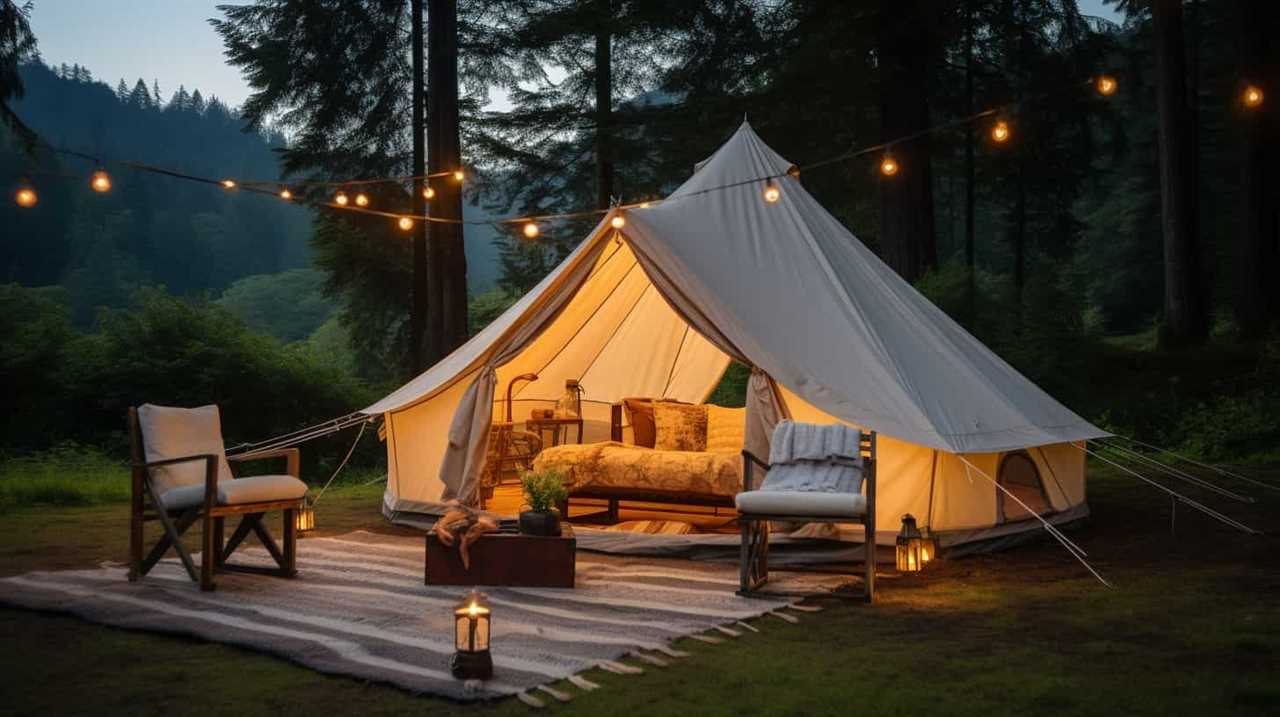
- Choose sustainable materials: When packing for our luxury camping trip, it’s important to opt for environmentally-friendly gear and supplies. Look for products made from recycled or organic materials, and avoid single-use plastics whenever possible.
- Reduce energy consumption: Luxury camping often involves the use of electronic devices and appliances. To minimize our energy consumption, we can use energy-efficient equipment, such as solar-powered chargers and LED lights. Additionally, we can be mindful of our energy usage by turning off devices when not in use.
- Practice responsible waste management: Transitioning into the subsequent section about responsible waste management, we can ensure that we leave no trace by properly disposing of our waste. This includes packing out all trash, recycling where available, and using biodegradable products when possible.
Responsible Waste Management
We can further minimize our environmental impact during luxury camping by practicing responsible waste management and adhering to the principles of Leave No Trace. Responsible waste disposal is crucial in preserving the natural beauty of our surroundings. By using eco-friendly disposal methods, we can ensure that we leave the campsite as pristine as we found it. Here are some practical tips for responsible waste management:
| Waste Type | Eco-Friendly Disposal Methods | Why It Matters |
|---|---|---|
| Food waste | Composting or using a bio bag | Prevents wildlife disturbances and reduces methane emissions |
| Plastic waste | Recycling or using reusable containers | Reduces plastic pollution and landfill waste |
| Human waste | Using designated toilets or burying waste | Prevents contamination of water sources and protects human health |
| Greywater | Properly disposing or filtering it | Minimizes pollution and protects aquatic ecosystems |
Embracing Renewable Energy Sources
To achieve a truly sustainable and eco-friendly luxury camping experience, our focus should be on adopting renewable energy sources. Here are some renewable energy options and solar power alternatives that can greatly enhance your camping experience:
- Solar Panels: Install solar panels on the roof of your camping tent or cabin to harness the power of the sun. This will provide you with clean and sustainable electricity to charge your devices, power your lighting, and run small appliances.
- Portable Solar Chargers: Invest in portable solar chargers that can be easily carried around during outdoor activities. These chargers can harness solar energy to charge your smartphones, tablets, and other gadgets on the go, reducing the need for disposable batteries.
- Solar-Powered Lighting: Opt for solar-powered lighting solutions such as solar lanterns and string lights. These eco-friendly alternatives will illuminate your campsite while minimizing your carbon footprint.
Supporting Local and Organic Products
When choosing our provisions for luxury camping, we prioritize purchasing local and organic products. Supporting local farmers and making eco-conscious purchasing choices not only benefits the environment but also connects us to the community we’re visiting. By buying locally, we reduce the carbon footprint associated with transportation and support the local economy.
Moreover, choosing organic products ensures that we’re consuming food and using products that are free from harmful chemicals and pesticides. It allows us to enjoy the natural flavors and benefits that come from sustainable farming practices.

So, when stocking up for our luxury camping adventure, let’s seek out local farmers’ markets and organic stores to make responsible and environmentally friendly choices.
Transitioning into the next section, let’s also explore the importance of using natural and biodegradable toiletries.
Using Natural and Biodegradable Toiletries
How can we ensure that our luxury camping experience is environmentally friendly and sustainable? One of the ways is by using natural and biodegradable toiletries. Here are three tips for eco-conscious grooming during your camping trip:
- Choose natural beauty products: Look for toiletries that are made with natural ingredients and free from harmful chemicals. This not only benefits your skin but also reduces the impact on the environment.
- Opt for biodegradable packaging: When selecting toiletries, prioritize products that come in biodegradable packaging. This helps minimize waste and promotes sustainability.
- Properly dispose of toiletries: After using your toiletries, make sure to dispose of them properly by following the recycling guidelines or using designated waste disposal methods. This ensures that they don’t end up polluting the natural environment.
By incorporating these practices into your camping routine, you can enjoy a luxurious experience while also being mindful of the environment.
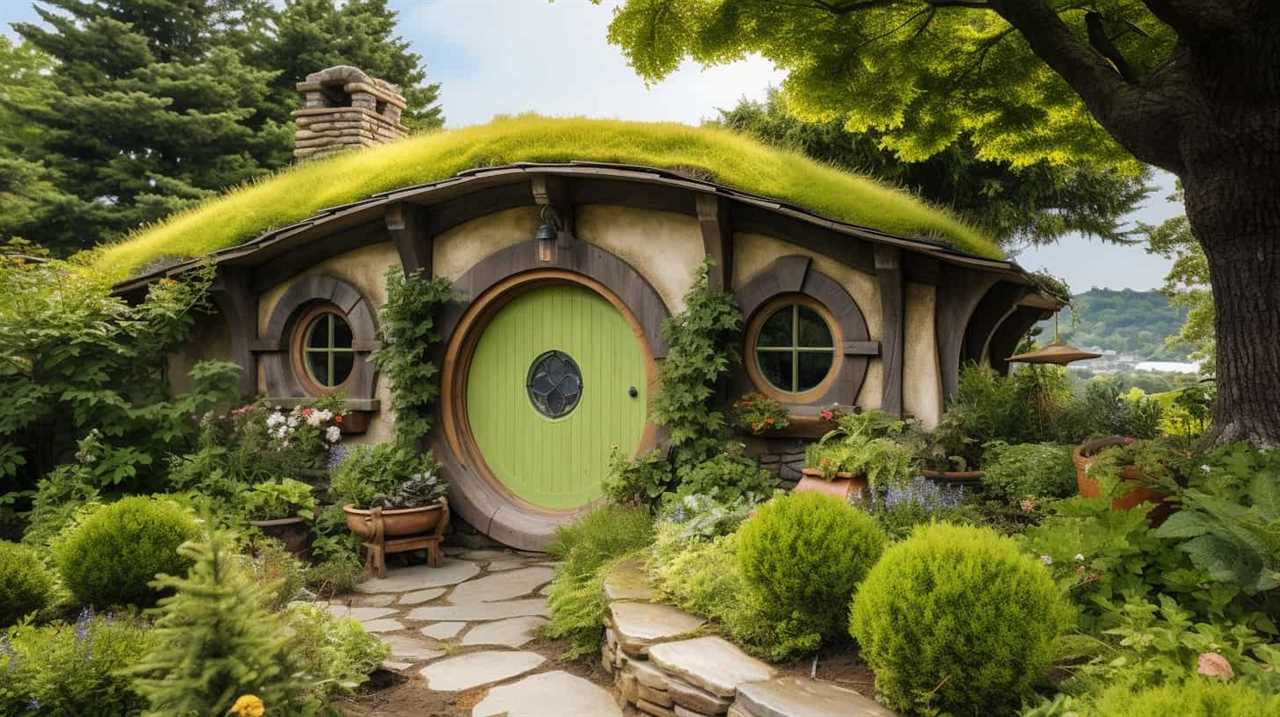
Now, let’s transition into the next section and discuss how we can engage in wildlife conservation during our camping trip.
Engaging in Wildlife Conservation
We can actively contribute to wildlife conservation during our luxury camping experience by being responsible and respectful stewards of the natural environment. Engaging in responsible wildlife tourism is essential for the preservation of our planet’s biodiversity. Here are some practical tips to help us make a positive impact on wildlife conservation efforts:
| Tips for Engaging in Wildlife Conservation | Benefits |
|---|---|
| Observe wildlife from a safe distance | Protects animals and their habitats |
| Avoid feeding or touching wildlife | Prevents dependency and disruption |
| Stay on designated trails and paths | Minimizes disturbance to wildlife |
| Support local conservation organizations | Contributes to long-term sustainability |
Encouraging Responsible Tourism
To further promote responsible tourism, it’s important that we continue to prioritize the well-being of the environment and its inhabitants.
Here are three responsible tourism initiatives and eco-conscious travel tips that can make a difference:

- Support local communities: Choose accommodations and activities that benefit the local economy and culture. By supporting local businesses, you contribute to the sustainable development of the community.
- Minimize waste: Reduce your environmental impact by using reusable water bottles, bags, and toiletries. Avoid single-use plastics and dispose of waste properly to keep the surroundings clean.
- Respect wildlife and natural habitats: Observe wildlife from a safe distance and avoid any actions that could harm or disturb them. Stay on designated paths to protect fragile ecosystems and leave nature as you found it.
Reducing Carbon Footprint
One approach to reducing our carbon footprint during luxury camping is by implementing sustainable transportation methods. Choosing alternative modes of transportation, such as electric vehicles or bicycles, can significantly reduce the emissions produced during travel. Additionally, opting for public transportation or carpooling with fellow campers can further minimize the environmental impact.
Another way to reduce transportation-related carbon emissions is by selecting camping sites that are easily accessible, thus minimizing the need for long-distance travel. Furthermore, embracing sustainable energy sources, such as solar or wind power, can help power the camping equipment and reduce reliance on non-renewable resources.
Promoting Biodiversity and Native Plants
Let’s explore the importance of incorporating a variety of native plants to promote biodiversity during eco-friendly luxury camping. By focusing on native plant restoration and promoting pollinator habitats, we can create a thriving ecosystem that benefits both the environment and our camping experience.
Here are three ways to achieve this:
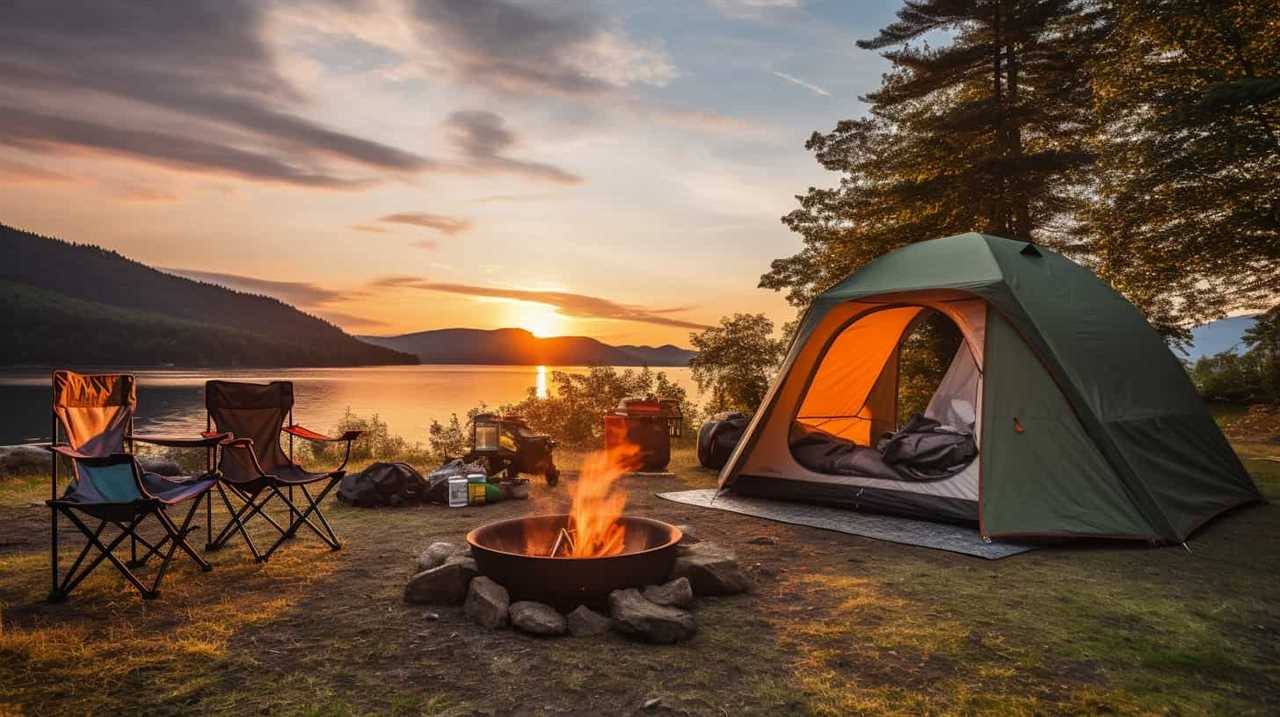
- Choose native plants: Selecting plants that are native to the area ensures they’re well-suited to the climate and soil conditions, reducing the need for excessive watering and fertilizers.
- Create pollinator-friendly spaces: By including a variety of flowering plants, you can attract bees, butterflies, and other pollinators. This not only enhances the beauty of your campsite but also supports the local ecosystem.
- Avoid invasive species: Invasive plants can outcompete native species and disrupt the balance of the ecosystem. Be mindful of the plants you bring to your campsite and make sure they aren’t invasive.
Educating Others on Eco-Friendly Camping Practices
Let’s talk about the importance of spreading green camping awareness and educating others on eco-friendly camping practices.
By initiating eco-friendly camping campaigns and teaching sustainable camping techniques, we can inspire others to minimize their impact on the environment.
Through these efforts, we can create a community of conscientious campers who prioritize the preservation of nature and contribute to a more sustainable future.
Spreading Green Camping Awareness
We can promote eco-friendly camping practices by sharing our knowledge and encouraging others to adopt sustainable habits. Here are three ways we can spread green camping awareness:

- Organize workshops and events: Host workshops or events to educate campers about green camping initiatives and provide them with eco-conscious camping tips. These interactive sessions can cover topics such as waste management, energy conservation, and Leave No Trace principles.
- Utilize social media platforms: Share our experiences and tips on social media platforms to reach a wider audience. By posting pictures, videos, and informative content about eco-friendly camping practices, we can inspire others to follow suit and make conscious choices while camping.
- Collaborate with camping organizations and influencers: Partner with camping organizations and influencers who share our passion for sustainable camping. By joining forces, we can amplify our message and reach more people, encouraging them to adopt eco-friendly practices.
Eco-Friendly Camping Campaigns
To further promote eco-friendly camping practices, we can initiate and participate in educational campaigns that aim to educate others on the importance of sustainable camping practices. By spreading awareness about eco-friendly camping products and initiatives, we can inspire others to adopt more environmentally conscious habits while enjoying the great outdoors.
One way to educate others is by organizing workshops or seminars that focus on sustainable camping practices. These sessions can cover topics such as Leave No Trace principles, responsible waste management, and the use of eco-friendly camping products. Additionally, we can collaborate with local outdoor organizations and government agencies to create informational brochures or online resources that provide practical tips for eco-friendly camping.
Social media platforms can also be powerful tools for spreading the word. We can use hashtags and share informative posts about sustainable camping practices, highlighting the benefits of using eco-friendly camping products and participating in eco-friendly camping initiatives.
Teaching Sustainable Camping
Through organizing workshops and seminars, we can actively engage in teaching others about sustainable camping practices. Here are three key ways to educate others on eco-friendly camping practices:

- Demonstrate sustainable camping techniques: Show participants how to properly dispose of waste, minimize water usage, and reduce energy consumption. Teach them about Leave No Trace principles and the importance of respecting nature.
- Share knowledge on eco-friendly gear: Educate campers on the benefits of using eco-friendly camping gear, such as biodegradable toiletries, reusable utensils, and solar-powered equipment. Explain how these choices can minimize their environmental impact.
- Promote responsible outdoor ethics: Emphasize the significance of preserving natural habitats and wildlife. Teach campers about the importance of staying on designated trails, avoiding wildlife disturbances, and practicing responsible fire use.
Frequently Asked Questions
Are Luxury Camping Sites More Expensive Than Traditional Camping Sites?
Luxury camping sites are worth the extra cost as they offer superior amenities and experiences compared to traditional camping. From comfortable accommodations to gourmet meals, they provide a more intimate and indulgent camping experience.
Can I Bring My Own Camping Gear to an Eco-Friendly Campsite?
Yes, you can bring your own camping gear to an eco-friendly campsite. Using personal gear allows you to reduce waste and minimize your environmental impact. Additionally, there are many eco-friendly camping gear options available for purchase.
How Can I Ensure That the Ingredients I Use for Cooking Are Sustainable?
To ensure sustainable sourcing and ethical cooking, we prioritize using locally sourced ingredients, supporting organic farms, and minimizing food waste. By making conscious choices, we can enjoy delicious meals while reducing our environmental impact.
What Are Some Easy Ways to Conserve Water While Camping?
Reduce water usage with these eco-friendly camping hacks. We’ve found easy ways to conserve water while camping, so you can enjoy a luxurious experience while being mindful of the environment.
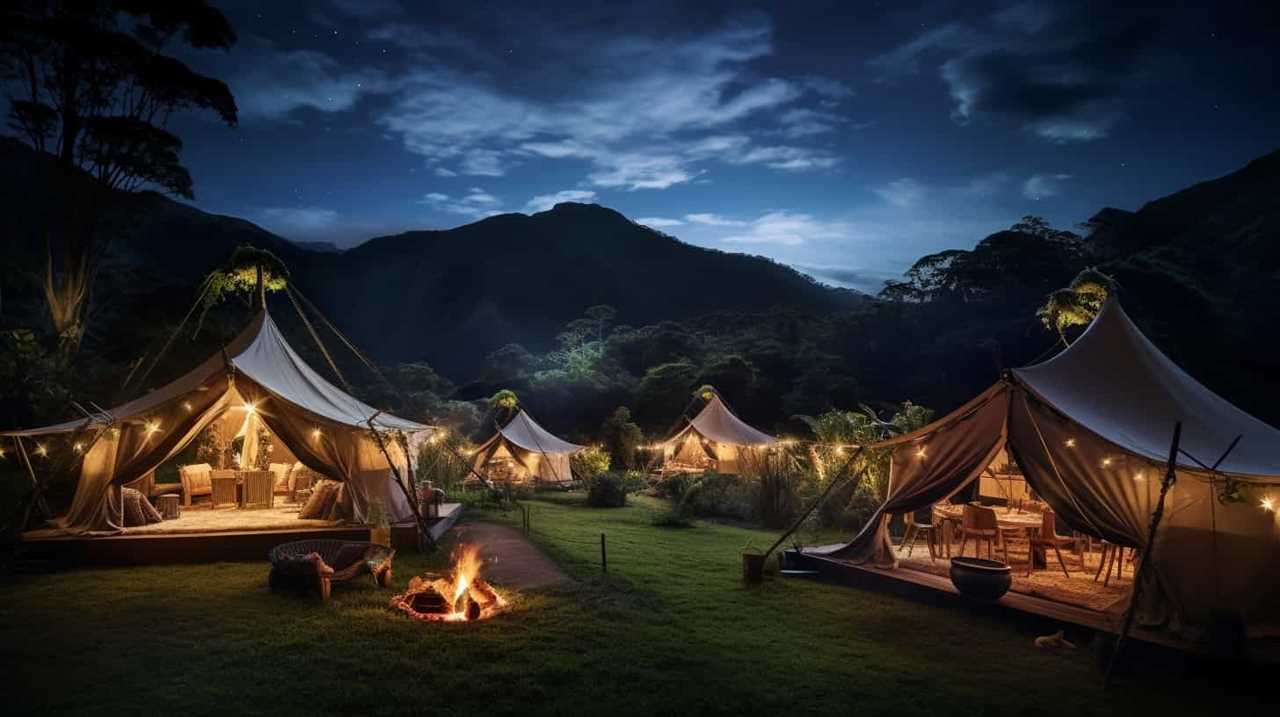
How Can I Reduce My Carbon Footprint While Camping?
To reduce our carbon footprint while camping, we focus on reducing waste and using eco-friendly camping gear. By being mindful of our choices and making small changes, we can enjoy a sustainable and luxurious camping experience.
How Can I Practice Sustainable Camping in Luxurious Locations?
Experience sustainable luxury camping at the top luxury camping locations. Choose resorts that prioritize environmental conservation and minimize their impact on the surrounding ecosystem. Look for accommodations with eco-friendly features like solar power, sustainable water usage, and locally sourced materials. Enjoy the beauty of nature while minimizing your footprint.
Conclusion
In conclusion, by following these sustainable tips for eco-friendly luxury camping, we can make a positive impact on the environment while still enjoying our outdoor adventures.
So why not choose eco-friendly campsites, minimize waste, use sustainable gear, cook with sustainable ingredients, conserve water and energy, encourage responsible tourism, reduce our carbon footprint, promote biodiversity, and educate others on eco-friendly camping practices?
Together, we can create a greener and more sustainable future for generations to come.

Happy camping!

